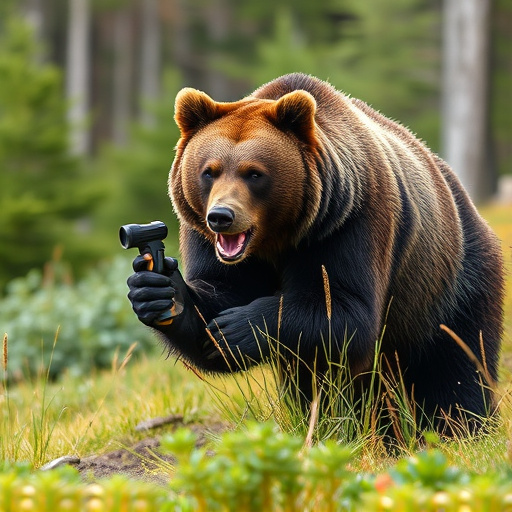Bear spray, a popular defense against bears in Alaska and other regions, relies on capsaicin from chili peppers as its active ingredient. While effective, it's susceptible to degradation over time, especially in warmer climates, impacting its potency. The Environmental Effects of Bear Spray Decomposition pose a significant concern due to potential water and soil contamination, affecting local wildlife. Natural, plant-based bear repellents offer an eco-friendly alternative with proven efficacy, reducing environmental impact compared to conventional sprays. Understanding real-world performance factors like wind, temperature, and proper disposal is crucial for maximizing safety in bear country while mitigating ecological damage.
“Alaska’s rugged landscapes are home to formidable bears, making bear repellents an essential tool for adventurers. This comprehensive guide delves into the science behind these defenses, exploring critical aspects like composition and effectiveness of bear spray, as well as its environmental impact from a unique perspective.
We dissect the mysterious ‘maximum range’ claim, revealing its complexities and limitations. Furthermore, we present sustainable alternatives and their efficacy in bear country, offering a balanced approach to staying safe in Alaska’s wild realm.”
- Understanding Bear Spray: Composition and Effectiveness
- The Environmental Impact of Bear Repellents: A Closer Look
- Deconstructing 'Maximum Range': What It Means and Its Limitations
- Sustainable Alternatives and Their Efficacy in Bear Country
Understanding Bear Spray: Composition and Effectiveness
Bear spray, also known as grizzly repellant, is a crucial tool for individuals venturing into bear country. Its composition varies, typically containing capsaicin, a compound derived from chili peppers, mixed with a carrier oil and other additives. This potent mixture is designed to create a temporary yet effective barrier against bears when used correctly. When an individual sprays in the face of an approaching bear, the irritant gets into the animal’s eyes, nose, and mouth, causing them to recoil and retreat.
The effectiveness of bear spray isn’t solely based on its chemical composition but also on proper usage. Factors like the distance from the bear, wind direction, and the sprayer’s technique significantly influence its success. Moreover, understanding the environmental effects of bear spray decomposition is essential. Over time, the spray can break down, especially in warmer climates, reducing its potency. This is why regular maintenance and checking the expiration date are vital to ensure maximum protection when facing a bear encounter.
The Environmental Impact of Bear Repellents: A Closer Look
Bear repellents, especially those based on capsaicin or other chemical compounds, have become popular tools for outdoor enthusiasts and residents living in bear-inhabited areas, like Alaska. While their effectiveness is well-documented, it’s crucial to consider the environmental impact of these products, particularly their decomposition. Bear spray, when used correctly, can significantly reduce the risk of bear encounters and potential attacks. However, once dispensed, these chemicals enter the ecosystem. The Environmental Effects of Bear Spray Decomposition play a critical role in understanding the long-term consequences for both wildlife and human activities.
The breakdown of bear repellents can impact water sources and soil quality, affecting not just bears but also other plants and animals. Chemical residues may persist in the environment, potentially harming non-target species and disrupting local ecosystems. Moreover, improper disposal or accidental release into sensitive habitats can lead to concentrated toxicities, causing unforeseen ecological damage. Therefore, responsible usage and proper disposal methods are essential to mitigate these environmental effects, ensuring that bear repellents serve their purpose without causing unintended harm to Alaska’s unique ecosystem.
Deconstructing 'Maximum Range': What It Means and Its Limitations
Understanding “maximum range” in bear repellent products is essential, but it’s crucial to deconstruct this term and recognize its limitations. The maximum range often advertised for bear spray is typically based on laboratory tests under ideal conditions. These tests measure the concentration of active ingredients remaining in the spray as it travels through the air. However, real-world scenarios differ significantly from these controlled environments.
Factors like wind speed, temperature, humidity, and terrain can greatly affect the effectiveness and range of bear repellent spray. For instance, strong winds can dissipate the spray quickly, reducing its impact on bears. Additionally, environmental degradation over time influences the product’s performance. The Environmental Effects of Bear Spray Decomposition play a role; as the spray ages or interacts with various surfaces, its potency can wane, further limiting its maximum effective range.
Sustainable Alternatives and Their Efficacy in Bear Country
In recent years, there’s been a growing interest in sustainable alternatives to traditional bear repellents, particularly those that contain harmful chemicals. One popular option is using natural sprays derived from plants known for their pungent odors, such as capsaicin from chili peppers or citruses like lemon and orange peels. These eco-friendly repellents are biodegradable, meaning they don’t leave behind persistent chemical residues in the environment. This is a significant advantage over conventional bear spray, which can have long-lasting environmental effects, especially in delicate ecosystems.
The efficacy of these natural alternatives has been studied extensively. Research suggests that when used correctly, plant-based repellents can be just as effective as their synthetic counterparts in deterring bears. As the demand for more sustainable options increases, further innovations and improvements in these products are expected, offering a promising path forward for those seeking to protect themselves while minimizing environmental impact in bear country.
In examining the guard Alaska bear repellent maximum range, it’s clear that understanding the composition and environmental impact of bear spray is key. The ‘maximum range’ claim often oversimplifies a complex issue, as the effectiveness of repellents varies based on factors like decomposition and wind patterns. Moreover, exploring sustainable alternatives offers promising solutions for minimizing the environmental effects of bear spray while maintaining safety in bear country. By considering both the science behind these products and their ecological footprint, individuals can make informed choices that contribute to a more balanced and harmonious coexistence with bears.
